COAL HANDLING PLANT
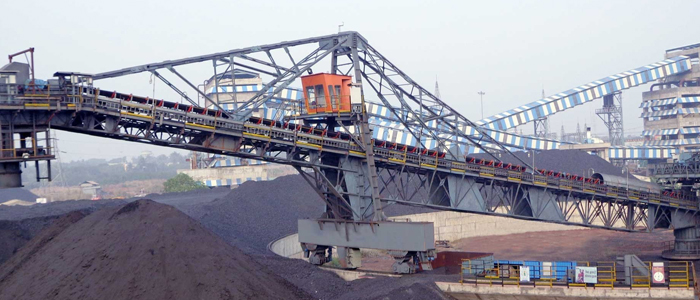
Coal mining in India began in 1774 in the Raniganj Coalfield along the Western bank of the Damodar River. As on 31 March 2015, India had estimated coal reserves of 306.6 billion metric tons, the fifth largest coal reserves in the world. India is the fourth largest producer of coal in the world, producing 536.5 million metric tons in 2014. Due to high demand and poor average quality, India is forced to import high-quality coal to meet the requirements of steel plants. India’s coal imports have risen from 43.08 million metric tons in 2006-07 to 199.88 million metric tons in 2015-16. India’s coal exports rose from 1.55 million metric tons in 2006-07 to 2.45 million metric tons in 2009-10 but subsequently declined to 1.25 million metric tons in 2015-16.
Coal handling plants are the key requirement of a coal-based thermal power plant, more than 62% of India’s electricity demand is met through the country’s vast coal reserves The efficiency of the boiler depends on the coal inserted in its burning chamber and the quality of coal is dependent on the coal handling system and its processes.
Coal handling plants are designed to meet the boiler requirement in terms of capacity and quality. CHAUHAN ENGITECH has supplied various capacity coal handling plants in different regions of India and foreign. CHAUHAN is designing & manufacturing various equipment to satisfy the needs of this kind of plant i.e.
- Belt Conveyors
- Grizzly Feed Hoppers
- Gates
- Bucket Elevators
- Crushers
- Vibrating Screen
- Metal Detector
- Magnetic Separators
- Bunkers etc
CHAUHAN ENGITECH is also providing solutions for ash handling for coal-fired boilers using mechanical conveying methods.
SALT WASHERY PLANT
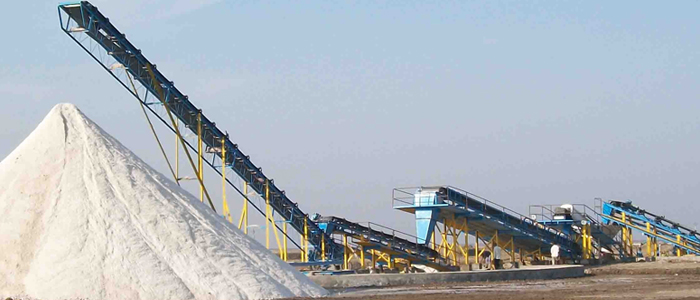
India is the third largest Salt producer in the World after China and the USA with Global annual production being about 230 million tonnes. The country produces about 27 million tonnes of salt. The growth and achievement of the Salt Industry over the last 60 years have been spectacular. When India attained Independence in 1947, salt was being imported from the United Kingdom & Aden’s to meet its domestic requirements. But today it has not only achieved self-sufficiency in the production of salt to meet its domestic requirement but also in a position of exporting surplus salt to foreign countries.
The major salt-producing states in India are Gujarat, Rajasthan, Tamil Nadu, Maharashtra, Andhra Pradesh and Odisha. Gujarat produces about 70 percent of the total salt, followed by Tamil Nadu. In 2014-15, the total salt production stood at 268.87 lakh (26.88 million) tonnes from approximately 6.16 lakh acres of land, according to an update by the Indian government on August 7, 2015.
The total human consumption of salt in India is about 59 lakh tonnes annually, with the rest – about 107 lakh tonnes – consumed by industries, according to Tata Chemicals, one of India’s corporate salt producers.
The raw salt is taken out from the sea, lake, or any other source, and cannot be used directly. To make it useful to human beings and/or industries, it is washed first to remove the impurities and to get the desired quality.
Salt washing involves many chemical and mechanical processes. ZEUS has vast experience in this field, and we are proud that the biggest salt washery plant having a capacity of 600 TPH in Asia is manufactured by us.
Zeus Engitech Pvt. Ltd. has a range of equipment as below to achieve the requirements of any salt washing plant.
- Feed Hopper
- Gates
- Belt Conveyors
- Screw Classifier,
- Metallic Belt Conveyor,
- Static Screen,
- Tripper conveyor,
- Stacker Conveyor
FERTILIZER HANDLING SYSTEM
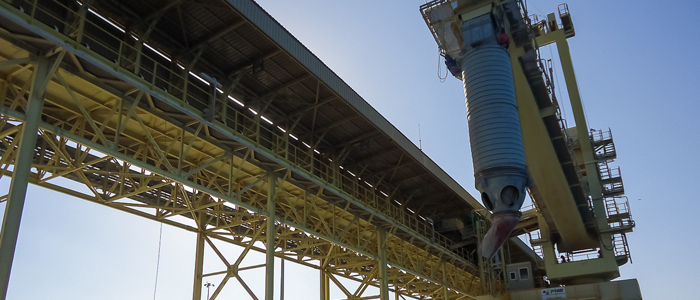
India today is the third largest producer of nitrogenous fertilizers in the world only behind China and USA. At present, there are 30 large size units in the country producing urea (as on date 29 are functioning) 21 units produce DAP and complex fertilizers, 5 units produce low analysis straight nitrogenous fertilizers. Besides, there are about 80 small and medium scale units in operation producing single super phosphate (SSP). The total installed capacity of fertilizer production, which was 119.60 LMT of nitrogen and 53.60 LMT of phosphate as on 31.03.2004, has marginally increased to 120.61 LMT of nitrogen and 56.59 LMT of phosphate as on 31.03.2011.
The history of the Indian fertilizer industry dates back to 1906, when the first fertilizer factory opened at Ranipet (Tamil Nadu). Since then, there have been major developments in terms of both the quantity and the types of fertilizers produced, the technologies used and the feedstocks employed. The fertilizer industry in India is in the core sector and second to steel in terms of investment.
India imports mainly urea, DAP and potassium chloride (MOP). The country has almost reached self-sufficiency in urea production.
Fertilizer consumption was less than 1 million tonnes before the mid-1960s. With the introduction of high-yielding variety (HYV) seeds, there was acceleration in the growth of fertilizer consumption. It reached 12.73 million tonnes in 1991/92 as against 0.78 million tonnes in 1965/66. After the decontrol of P and K fertilizers the growth in consumption slowed. The highest consumption was recorded in 1999/2000 (18.07 million tonnes of nutrients).
ZEUS has supplied a different kinds of equipment for handling various kinds of fertilizers like Urea, DAP, MOP, and NPK. Belt conveyor, some of the main equipment supplied by ZEUS in many fertilizer plants in India are: Belt Conveyor
- High Angle Belt Conveyor (Steep Angle Belt Conveyor)
- Polishing Screen
- V – Plough Feeders
- Bunker Feeding System
- Bag Weighing System
COAL SCREENING PLANT
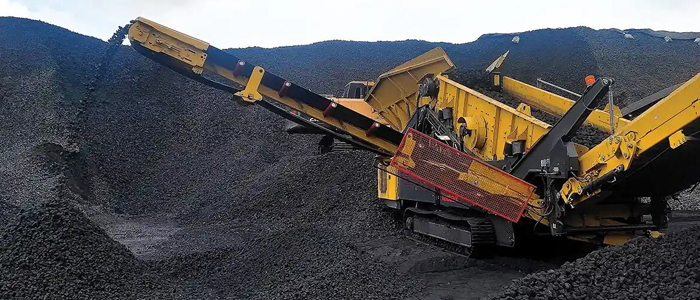
Coal has very significant value among all the minerals and organic materials. Coal is dug from the coal mines that have varied in size from very big size lumps to powder form. As coal is required for various applications the size of coal suits the requirement.
In the earlier days, the sizing of coal was a difficult task but now using a coal screening plant it is very easy to seize. There is various equipment is used to get the desired output and quality from the feed coal.
The whole operation can be categorized into the below operations.
- Conveying
- Crushing
- Screening Based on the feed size and require output size of coal the whole process is designed. This process involves
- Feed Hoppers
- Gates
- Feeders
- Primary crusher
- Secondary crusher
- Vibrating/rotary screen and
- Belt conveyors.
As mentioned above the specification of required output and feed coal size decide, what equipment to select. Sometimes the requirement of coal screening is limited up to two sizes only, in this kind of case there is no need for any crushing equipment and thus crushers can be eliminated from the process.
ZEUS has supplied these kinds of plants in different locations all over India. ZEUS is designing & manufacturing all kinds of equipment to satisfy the need for a coal screening plant.
BIOMASS HANDLING SYSTEM
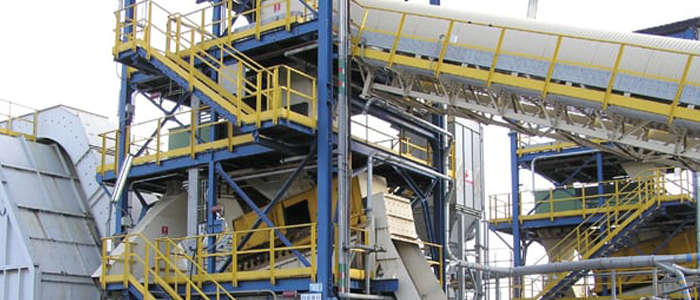
In today’s world the demand of fuel is rising day by day and the resources are very limited. Now people are thinking to use non-conventional sources of energy in place of conventional energy sources i.e. coal, oils and gases.
There are various options are available in non – conventional energy sources to take place of conventional sources of energy. The main conventional energy sources are Solar, Wind, Hydro power Biomass etc.
Every conventional energy sources have some limitations i.e. solar plants cannot run without the sun light in night also the climate plays an important role in the efficiency of any solar plant. Same things apply to wind and Hydro (Water) operated plants. Another the solar energy, wind energy or hydraulic energy cannot be stored for use in future.
But in the case of biomass these issued are not faced. The biomass can be stored as per the requirement and can be used based on the demand of power generation. The biomass fired power plant can be run in night also.
India is a country of farmers and we produced about 450-500 million tons of biomass per year. And using this we generate 32% of all the primary energy use in the country at present. Today we are using different kind of biomass to fulfill our requirement of energy i.e. wood chips, wood savings, saw dust, cotton stalk, rice husk, bagasse etc.
These biomass are available in different forms and sizes and so the handling of these is unique based on them. So the design of system for handling the biomass to be specific and full proof.
ZEUS is dealing with and making equipment for different kinds of biomass from many years. Some of the equipment used to match the process requirements are as under:
- Belt conveyor
- Apron Feeder
- Bucket elevator
- Screw conveyor
- Live Bottom Silo
- Drag Chain Conveyor
- High Angle Belt Conveyor
- Rotary screen
- Vibrating screen
TRUCK LOADING SYSTEM
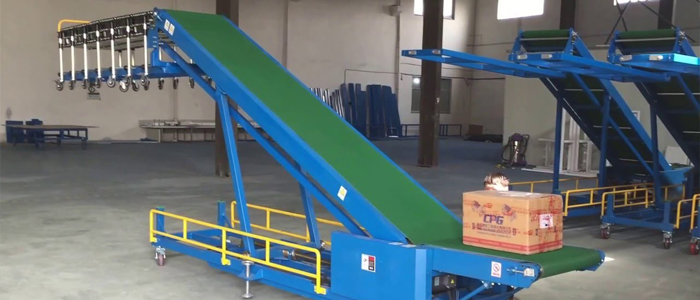
There are two methods in practice for handling bulk cargo.
• Mechanical Handling – using grab buckets, cranes, and belt conveyors
• Pneumatic Handling – Using a vacuum pneumatic system.
In the mechanical handling operation, very heavy machines are used to handle the material. Also in this kind of operation the equipment and human safety are always to be taken care of very seriously. While this operation is done in the port, the barge or ship has to move forward or backward to empty the material because the crane and grab bucket can not move parallel to them. As the equipment used in this kind of operation are very heavy and very skilled manpower is required to operate them, the initial cost goes very high. Also for small ports or medium capacity material handling the operation and maintenance cost goes far from the limit.
The solution to this is pneumatic handling, using the vacuum method. In this kind of operation, the material is sucked by a pneumatic system using a vacuum pipe. The vacuum pipe used for this kind of operation is very flexible and thus it can be moved all over the vessel and so there is no need to shift the vessel after a certain time during the operation.
In this system, less mechanical equipment is used &also the size of the machine and equipment is less than the mechanical handling. The safety of humans and machines can be taken care of nicely.
The material sucked by the pneumatic system comes into a silo, which has a dust collector to control the dust and discharge the access air and other equipment to discharge the material into a truck or other vehicle.
This system is very easy in handling and the maintenance cost is also less compared to the mechanical handling system.
If the particle size is suitable for pneumatic handling, this system is very effective and reliable.
MSW PLANT
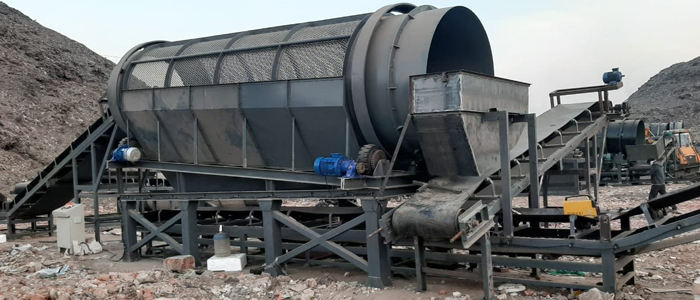
One of the major environmental problems that developing countries are facing is improper solid waste disposal and management strategies. Solid waste has been a major environmental issue. A major portion of the solid waste comes from school, home, offices, market, farms and other public places.In this some of the garbage, refuse, sludge, trash, and rubbish are biodegradable e.g., paper products, food droppings, as well as vegetation like grass and twigs, and others are not biodegradable and they include metals, aluminium cans, plastics, broken computers, and car parts. As they do not decay easily, they pile up in landfills and refuse dumps and these bring great harm to the water, land, and people around it.
India produces 277.1 million tonnes of solid waste every year.Which is likely to touch 387.8 million tonnes in 2030, and 543.3 million tonnes by 2050.
Country wise per person waste generation per day
India: 0.75kg
USA: 2.24kg
Bermuda: 4.54kg
By 2050, however, India’s figure is projected to increase by 900 gm every day. The waste management hierarchy consists of six stages:
- Prevention
- Minimization
- Reuse
- Recycle
- Energy Recovery
- Disposal
Now Reduction of solid waste is very challenging as the population is growing day by day and this cannot be achieved without strict govt. policies Reuse is depend completely on supply of that product, its cost and interest of public. Unless and until the substitute is available and one has purchasing power, we will not hesitate to throw the old one. Now rest two are achievable trough proper waste management and industrial processes.In these two RECOVERY is very important, as without recovery recycling is not possible. In the solid waste we find below materials:
- Paper 27%
- Food Waste 14.6%
- Yard Trimmings 13.5%
- Plastic 12.8%
- Metals 9.1% etc.
Note: The ratio may different from place to place
We at Zeus EngitechPvt. Ltd. has made sure to provide the most suitable equipment for managing and recycling the waste at every stage. We have designed manufactured, supplied, erected and commissioned complete systems upto a capacity of 300 tons per day. Theseplants have been satisfactorily performing to the rated capacity from the date of commissioning. The performance of the plant during commercial production, since last 4 years. We give after sales service, by way of timely supply of spares & deputation of our expert design and service engineer, as and when called for, to help, in the operation & maintenance of the plant.
FGD PLANT
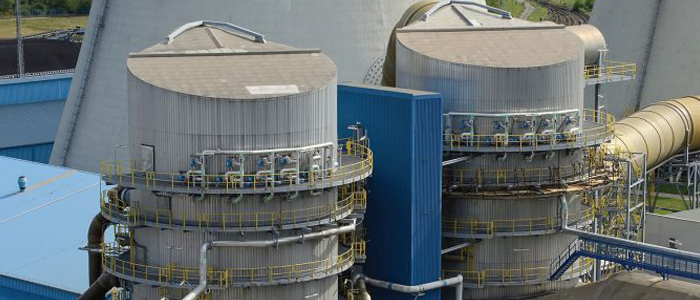
Zeus EngitechPvt. Ltd. is working under Thermax Ltd. on a power plant of 2X500 MW in Koderma which was under government threat since 2018 for violating pollution norms and they were asked by the government to pay a fine of around 150 Cr. If they do not control the SO2 emission content in the power plant by setting up an FGD plant within 3 years of time. The order was awarded to Thermax Ltd for setting up the FGD project which will help control the SO2 emission within the stipulated limits. There are many material handling equipment required for processing Limestone and Gypsum in this plant for which
CHAUHAN ENGITECH got the order from Thermax Ltd. in June, 2020. Zeus Engitech has supplied Flue Gas Desulphurization System is a process to remove Sulphur Dioxide (SO2) content from flue gases after burning the fuel i.e. coal, lignite, biomass, oil. From the data available up to 31st Oct 2020, the usage of fuel for electricity generation is as below and due to the burning of these fuels SO2 emission takes place.
How to control SO2
- Fuel Desulphurization:
- Fuel Gas Desulphurization:
- Purpose of the FGD system
Method to Remove SO2 in the fuel prior to combustion. This brought the efficiency of the boiler down and the life of the boiler reduced by approx 5 years.
Method to remove SO2 from flue gases after combustion. By doing this the efficiency of the boiler remains as per design and the life also increases.
To remove Sulphur content in flue gases after fuel combustion. Chemical reaction in FGD Process: Sulphur Dioxide (SO2) + Limestone (CaCO3) + Oxygen (O2) + Water (H2O) = Gypsum (CaSO4*2H2O) Carbon Dioxide (CO2)
